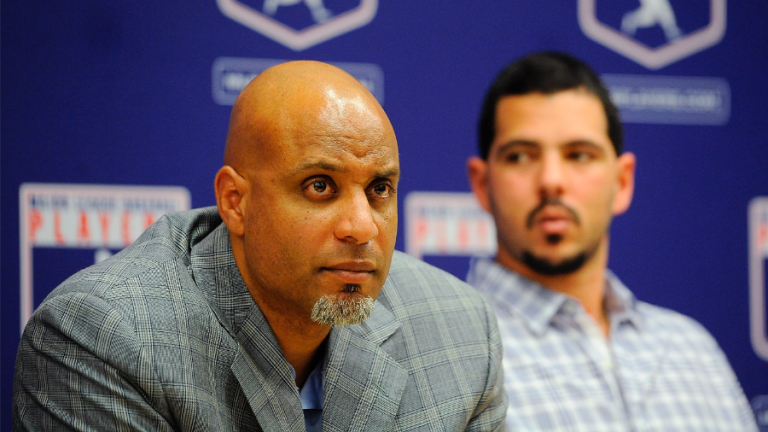
Friday afternoon, Buster Only of ESPN tweeted that the Major League Baseball Players’ Association is willing to go back the bargaining table with Major League Baseball, and re-open discussions about a 14-team postseason format.
Sources: As the two sides look to jump-start the CBA talks, the union has approached MLB with an offer to re-open talks on the 14-team postseason field, with the idea it can exchange this for more flexibility on the CBT numbers and other issues.
— Buster Olney (@Buster_ESPN) March 4, 2022
This is a significant development for several reasons. First, earlier this week, the MLBPA was said to be strongly against 14 teams qualifying for the playoffs, thinking that the easier entry into October would curtail spending. Second, estimates are that by having 14 teams in the playoffs, MLB would rake in an extra $100 million. This may enable the owners to move on the Competitive Balance Tax, the primary sticking point in the Collective Bargaining Agreement negotiations. Third, the wider playoff field may appease the small and mid-market clubs, who are concerned that a higher CBT threshold would tilt the balance too heavily toward the large-market teams.
Whether the possibility of an expanded postseason represents the breakthrough the stalemated talks need remains to be seen, but by backing off their objection, the players are making a large step in the owners’ direction. Of course, the union will want something significant in return, and that will very likely be concessions by MLB on the CBT thresholds.
In 2021, the CBT threshold was $210 million, and so far in the bargaining sessions, the owners have been willing to raise the threshold to $220 million in year one of a new CBA, followed by modest increases in the subsequent years. Evan Drellich of The Athletic tweeted earlier on Friday that the offer of $220 million is not universally accepted by all the clubs.
Sources: Angels, Diamondbacks, Reds and Tigers owners opposed MLB luxury tax increase to $220 million. MLB also proposed including player meal money in calculation of luxury tax, which irked players. https://t.co/gBKrqAx9wV
— Evan Drellich (@EvanDrellich) March 4, 2022
The MLBPA wants the tax threshold to be $238 million in year one of a new CBA (as of March 1), escalating to $263 million in year five. It’s hard to imagine that the players will lower their ask on the CBT threshold after agreeing to a 14-team postseason, something the owners wanted earlier in the week, but backed down to 12 teams when the union strongly objected.
The remaining issues and how they may play out have become clear. The MLBPA’s change of direction on the number of teams in the playoffs shows that they are focused on the CBT, so much so that they are willing to give on something that they, just days ago, rejected on the premise that it was bad for the game.
The lockout, and when it may end, will come down to how flexible the owners are willing to be on the CBT threshold (the two sides have reportedly agreed to keep the tax penalties the same as in the previous CBA). The owners could take the approach that they will be realizing $100 million more in revenue, and with more teams qualifying for the playoffs, the small and mid-market teams will have the chance to get in the tournament without necessarily having to compete on a financial basis. Those teams could also see additional income from increased attendance during the stretch drive. Will this be enough for them to agree on a significant rise in the tax threshold? Time will tell.
Commissioner Rob Manfred will need to have 23 clubs on board with a new CBA. His challenge in any scenario will be securing the votes of the small and mid-market teams. The increased television revenue and enhanced possibilities for postseason qualification will provide an incentive, whether or not that incentive is enough for the owners to collectively move on the CBT, and thus provide the pathway to a deal, will play out in the coming days.
More spring training games have been cancelled. The earliest an exhibition game can be played at this point in March 18, and that seems like a long shot. Two more regular season series will likely be wiped out early next week, moving the soonest possible Opening Day date to April 15.
It seems that the union is making the big move. Its willingness to open the postseason to 14 teams will at least get the owners and players back to the table. What happens next, good-faith bargaining or more saber-rattling, will determine if we can get the season started at some point during April, and salvage most of the regular season.
We do not know when the next round of talks will take place, but it should be soon. Instead of watching spring training games, we will watching for the results of talks that will take place in Manhattan.
So far, that’s baseball in 2022. Let’s hope that in the near future, the action will take place on the diamond.















